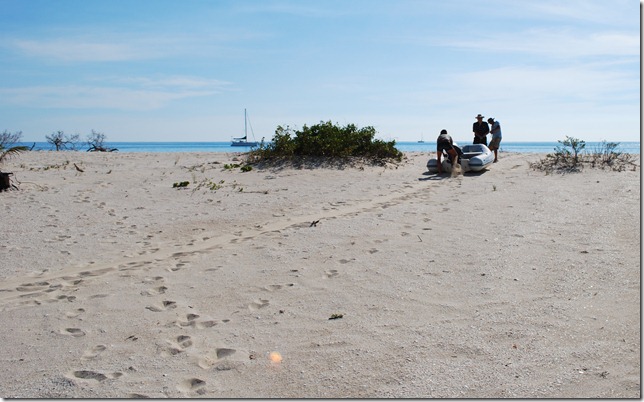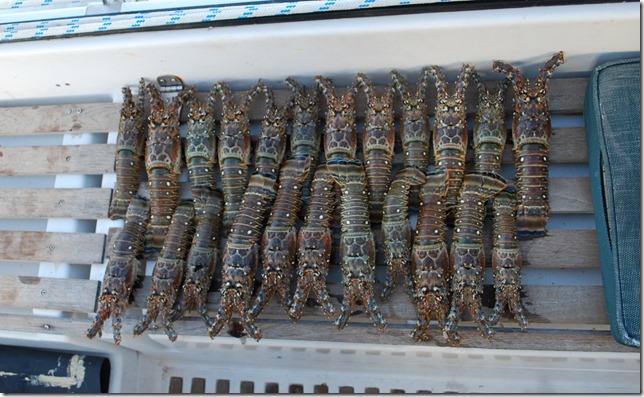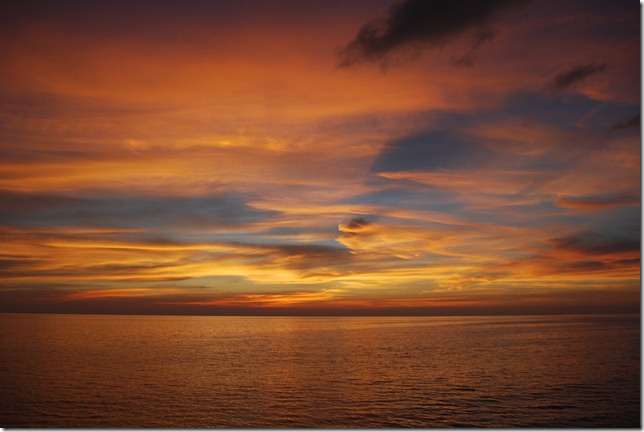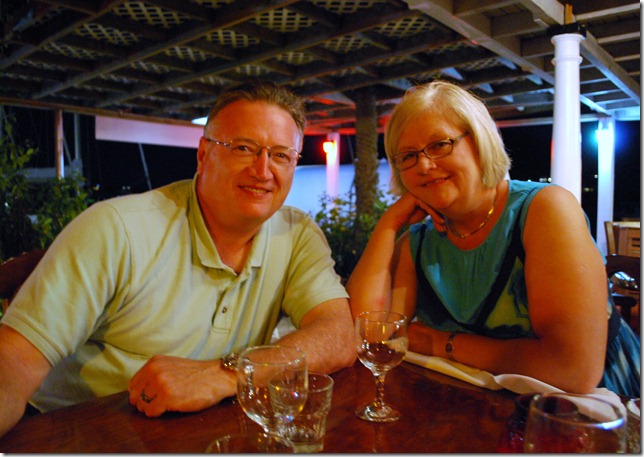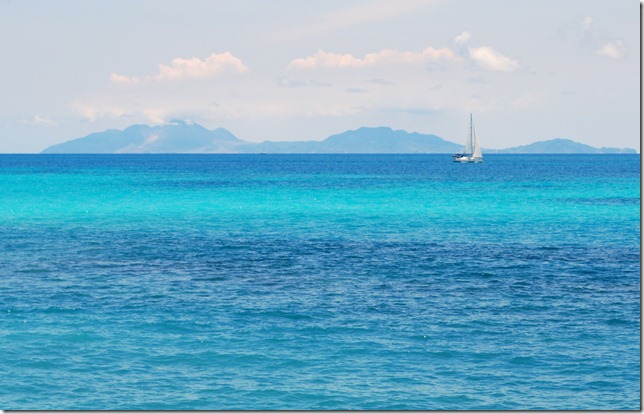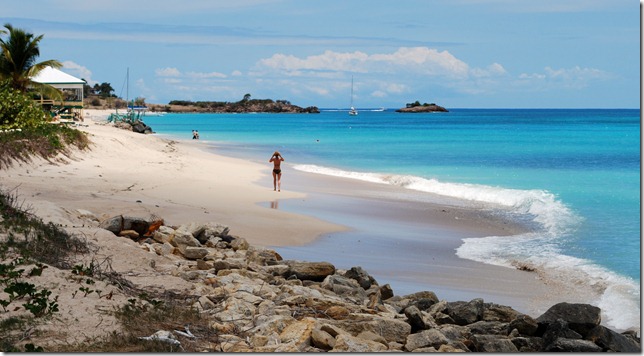Our pleasant stop in Antigua finally came to an end Thursday when Lauren and I weighed anchor early in the morning and headed for Barbuda. The sail from Antigua to Barbuda can be a pretty rough one, but the trades have been incredibly light (less than 10 knots) for the last week or so, leaving us to motor the 50 miles from English Harbour to Barbuda’s Low Bay.
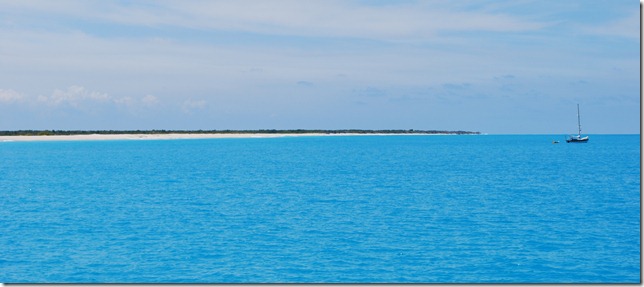 Barbuda is a postcard – gorgeous water, uncrowded anchorages, and empty beaches to the horizon
Barbuda is a postcard – gorgeous water, uncrowded anchorages, and empty beaches to the horizon
Barbuda is somewhat unique for the Caribbean. It’s a low island that has miles and miles of beautiful beaches but now has only one major resort left on the island, and it’s only open during the high season. Because it’s less visited, it has been the home to some pretty exclusive resort and celebrity guests – Princess Diana made several visits, and one resort has its own airstrip so that guests can skip the hustle and bustle of Barbuda’s public airport, with its one daily flight from Antigua. The fringing reefs, which extend well offshore, have claimed over 200 ships over the years, nearly all in the days before GPS and accurate charts. These days Barbuda’s claims to fame are less glamorous – lobsters, a bird sanctuary, and an interesting land act. Barbuda was originally leased to a single wealthy family (the Codrington’s) who used it primarily as a supply and slave depot for their other land holdings in the Caribbean. The island’s 1500 inhabitants are almost entirely descendants from those early slaves. Private property never really took hold in Barbuda, and today the Barbuda land act officially makes all the land in Barbuda the common property of all of the inhabitants of Barbuda. The Barbuda council is free to make leases with commercial interests and grant Barbudans land for houses, farming, etc., but there isn’t a single real estate agent to be found. It’s definitely a unique system, but the slow pace of life and absence of large-scale tourism seems to be the way most Barbudans prefer things.
One other very unique feature of the island is its large saltwater lagoon with the island’s only town, Codrington, located on its eastern shore. We’d been told in Antigua that the ferry bringing Lauren’s parents would land on the beach in Low Bay, but once in Barbuda, we quickly learned that wasn’t the case. The ferry actually comes to the south side of the island. Our backup plan was to meet in Codrington, and the place is small enough that “meet us in town” is actually enough to get the job done. The 2-mile dinghy ride from Low Bay to Codrington isn’t the difficult part of getting there (although in strong trades it is the wet part). The difficult part is hauling the dinghy over the sand spit separating Low Bay from the inner lagoon. Our dinghy and engine together weigh over 225 pounds, and dragging them up and across the 100 ft or so of sand spit called for lots of rest breaks.
After picking our anchoring and spit-crossing spot poorly on Thursday night, we re-anchored Friday morning right next to the best spot for crossing and were pretty happy to be across the spit in less than ten minutes. We reached the boat dock in Codrington just before Robin and Rindy pulled up in a taxi from the south side of the island, and together we began our day of Barbuda exploring. First up was lunch. We initially tried the one restaurant we’d spotted the previous evening. The painted sign above the door only said “REST”, but the missing space for more letters, roasting meat in the window, and two tables inside filled got the rest of the message across. It was closed and a second two-table restaurant we found wasn’t ready to serve food yet, so we headed for a roadside “no-table” restaurant that we’d sampled the night before and found to be a four-star sort of joint (as long as you’re only rating the quality of the food and the friendly company).
The stand’s proprietor, Washington, had outdone himself with jerk chicken, conch stew, dukanah (a local sweet, spiced dumpling), pastry, cooked vegetable “chop-up”, plantains, and potatoes. Next to the tiny shop where picked up cold beers to accompany our lunch, we found some loose cinder blocks in an unfinished (barely started) building and sat down in the shade to catch a break from the heat and enjoy our meal. Reviews were two-thumbs up for the food, but seating and ambiance isn’t quite ready for the cruise ships yet.
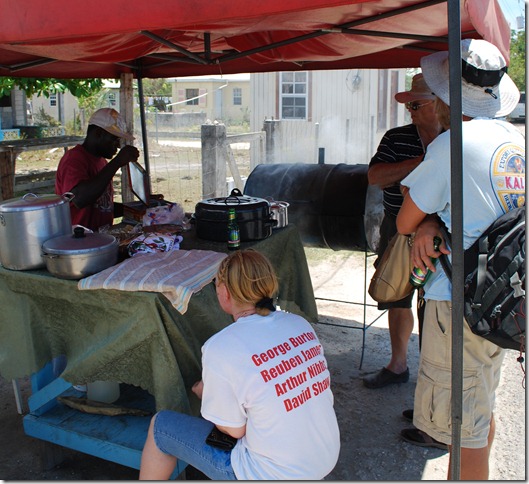 Barbuda’s local five-star dining
Barbuda’s local five-star dining
Good Friday is a holiday on Barbuda, and it took the better part of an hour and lots of help from locals to track down customs and immigration officers, get them to come to their closed offices, and get checked out. The customs guy in Codrington works out of a small room at the front of his house, has a hand-painted sign in the yard that says “customs”, and asked me for a job on board our “yacht”. He was a really friendly guy, but after I explained that our crew pays us instead of the other way around, he wasn’t too interested in a position.
Our next stop was the frigate bird sanctuary in the northern part of the lagoon. A local named Solomon took us on the short tour and we were impressed with large birds and how close they let us come in the boat. Frigate (or man-of-war) birds earned their name by harassing other birds in flight into surrendering their catch to supplement the fishing they do on their own. Although the frigate bird has the largest wingspan-to-weight (6-8 ft and only a few pounds) ratio of any bird, it can’t take off from the water, so it has to fly low and scoop small fish from the surface of the ocean instead of diving like a pelican. Barbuda has no natural predators and their nests in the mangroves are completely surrounded by water anyway, so the frigate birds seem to be pretty happy here. We even caught sight of several males, who are supposed to have migrated to other locations already.
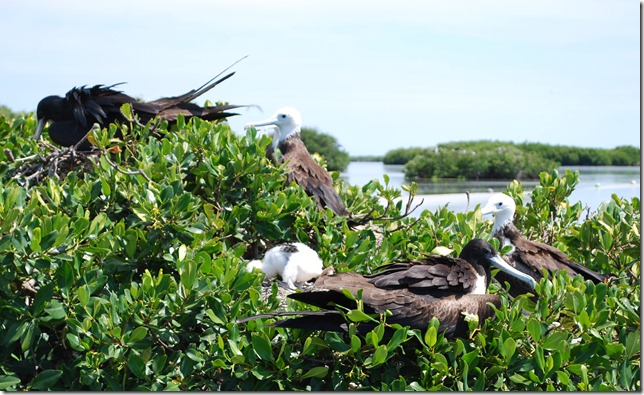 Male (all black top-left), female (white breast in foreground) juveniles (white heads), and chick (fluffy white in center) in the mangroves
Male (all black top-left), female (white breast in foreground) juveniles (white heads), and chick (fluffy white in center) in the mangroves
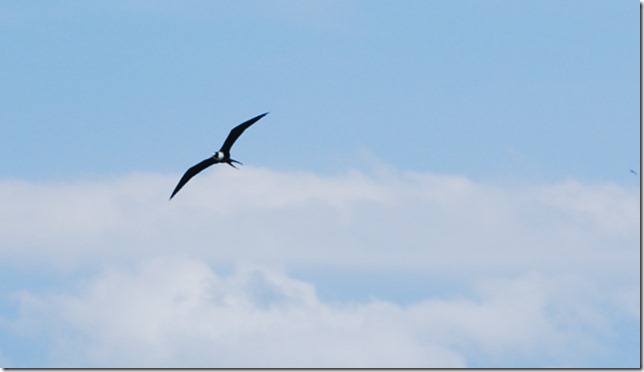 The frigate bird silhouette is distinctive
The frigate bird silhouette is distinctive
Barbuda is renowned for its plentiful spiny lobsters, but between the holiday and a local who buys up all the lobster daily to fly to Guadeloupe twice a week, I was having trouble finding any. The going rate is $5-6 USD/lb (live weight) so I was hoping to stock up. Solomon happened to have a 9 lb bag burlap bag of them hanging under the dock that he sold us before we left and as we motored back across the lagoon toward the spit, the driver of a local boat waved to us to stop. We’d heard “Goldilocks” was a fisherman that was a good bet for selling lobster, and it turned out to be him in the boat. He’s been lobstering in the lagoon and surrounding waters for 40 years and his day’s catch proved he’s pretty adept at it. Instead of traps, he uses a wire noose at the end of a metal rod. He slips the end of the noose around the lobster’s tail and when it moves, the noose tightens and into the bucket goes another lobster. It’s a technique we’d heard of before, but I never imagined it could be so effective.
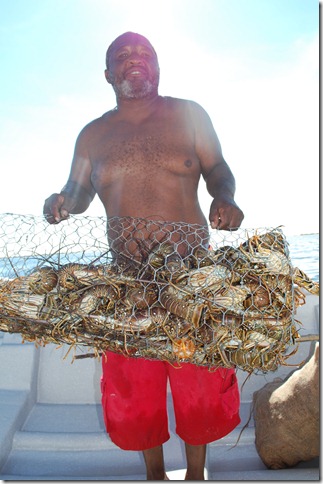 Goldilocks with about half his catch
Goldilocks with about half his catch
Back at the boat, we jumped into the turquoise water to cool down and then I started cleaning lobsters to store in the freezer. They weren’t large, but the final count was 23 of them for less than $60 USD. Not bad. After killing them and trimming a few extraneous parts they fit nicely into the freezer. Believe it or not, this was the first time on the trip Lauren had cooked lobster, and as usual she did an incredible job. Pan-fried with butter, garlic, and some fresh lime juice, they didn’t last long.
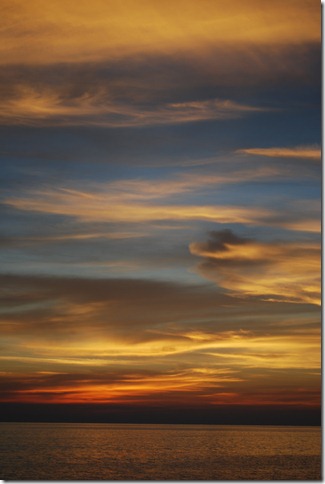 Robin’s sunset pictures made for some tough choices…
Robin’s sunset pictures made for some tough choices…
After dinner and a round of cards, we fired up an engine and started motoring toward St. Kitts. Sunrise found us just east of the Narrows between Nevis and St. Kitts and with the calm conditions, we were able to motor through the Narrows and up to Basse-Terre to clear in. A cruise ship had arrived just before us, and things were a bit of a circus during the check-in. It turns out that checking in the 3200 passengers and 1200 crew is no more difficult for them than checking us in, although our crew/passenger list is one page and theirs was thick enough to look like the white-pages. I’m pretty sure it will fall into the category of printed but never read.
After checking in, we moved over to South Frigate Bay for the night. I was pretty exhausted from the night sail and turned in early, but one of the clubs on the beach was having a 10th anniversary party that made getting to sleep a slow but melodious affair. A fireworks display overhead and a pretty talented band had things going strong well into the wee hours. As seems to be the case in many places here in the islands, the speakers were still pumping Caribbean dance music when the sun came up.
After two years of vicariously being aboard the Pura Vida, we, the proud parents of Lauren, were met by Dallas and Lauren at the V.C. Bird Airport to begin our Caribbean holiday. Our rental car also began its brutal venture with us as it stumbled over the many potholes, “speed humps”, and narrow two-lane roads that merged into one because of double-parked vehicles. Robin is our designated chauffeur and continues to remember to drive on the left-hand side.
One of many skills to be learned as part of the crew is how to enter and exit the dinghy. Multiple ways have been tried with varied levels of grace. The second lesson presented by the ever patient Dallas was how to drive the dinghy into the dock and the side of the boat without playing bumper boats. Use of the on-board head was the necessary third lesson.
Meals aboard the boat have ranged from fresh wahoo and mahi-mahi to Shrimp a la Lauren with red pepper sauce and coconut milk. Tonight is homemade tortillas for burritos. One evening eating out at La Mia Cucina, we were treated to red snapper. Who goes to the tropics without a pina colada and rum punch galore? A selection of local beers and S. African wines have rounded out our dining experiences.
Awaiting our fresh fish at the water’s edge at La Mia Cucina
This week in Antigua is called Antigua Classic Yacht Regatta. Spectacular super yachts were also on display in the marina. One that I had seen on the TV show “Wealth on the Water” , the Maltese Falcon, was amazing up close with electronically operated yard arms. In contrast to the flashy yachts, there was one sailboat built in 2003 from a 1908 design with no engine, yet sailed beside the more advanced boats with ease.
Antiguans have proven to be exceptionally friendly and helpful. When taking a “wrong” turn home one day, a young pickup driver assured us we were taking the local shortcut as he proceeded to lead us over a road we had previously determined was impassable. Robin agreed to follow the 4-wheel drive truck, and later, remembered he was in a low-riding Nissan. We determined a Nissan oil pan is substantial beyond all expectations and is qualified for off-roading …so far. On Palm Sunday we were blessed with attending the St. Barnabus Anglican church where Father David greeted the Kansan visitors with remarks about the KU Jayhawks and Kansas City Royals. Our hosts at the Blue Moon Antigua villa have been so kind to assist with reservations and directions to local attractions. Often we asked for directions along the road and each person’s answer was always cordial and accurate. One man said, “You are right on your journey.”
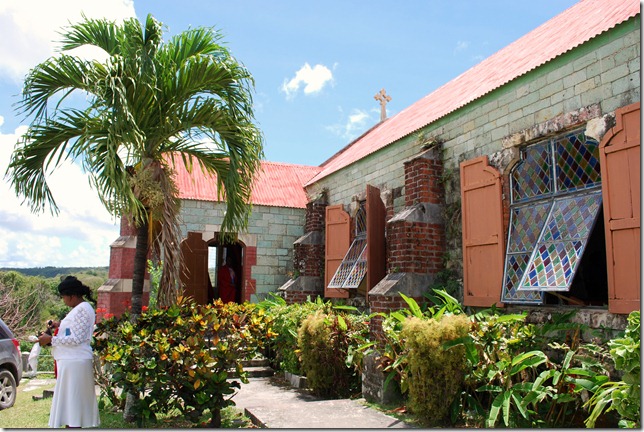 We were welcomed with open arms here even though the service had already started
We were welcomed with open arms here even though the service had already started
We are in awe of the natural beauty of the land. The flowers, plants and cactus that adorn the multi-step ascent to our villa makes the walk easier. The island of Montserrat is viewed (26 miles) in the distance where you see steam rising above the active volcano. Sunsets colors reflected in the clouds and water cannot be captured in our small camera lens, but will long be remembered. One day on our touring we stopped for lunch at a beachside cafe; as the sailboats passed in the distance, the palm trees and pink sand framed a picture that would make a Corona commercial proud. The shades of blue lived up to all our anticipation.
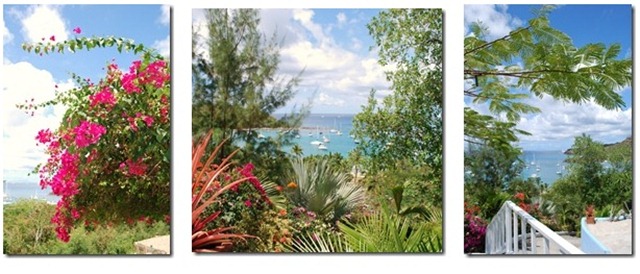 Views en route to the upper villa
Views en route to the upper villa
Shades of blue
Local attractions in the area recalled the days of slave trade, sugar plantations, and English/French military battles. Devil’s Bridge, an eroded cliff area creating an unsupported rock arch, was a site of suicide for slaves escaping the cruelty of their captivity. During a trek to a rainforest we stumbled upon a delightful artist, Sallie Harker, who had been selected as the artist to represent Antigua in the international sculpture show held in China.
Our upcoming sailing trips to Barbuda and St. Kitts should include additional chances for snorkeling, touring, and hopefully, fresh lobster eating! We appreciate Lauren and Dallas’s generosity in providing us with this unique opportunity.
We caught two buses to get to the airport on Thursday afternoon to pick up my parents. The ride across the island offered views of beautiful tropical flowers, unusual palm trees that look like fireworks exploding, and well maintained and colorful houses, and I was excited to share it all with them. A large group of tourists emerged from the airport terminal with lots of bags in tow, some of them obviously Americans loaded up with all the necessary gear for a destination wedding. We waited and waited, and no parents. When we were the only people left waiting for passengers to arrive, I started to wonder if I had noted their arrival time incorrectly, but eventually they appeared from the doorway with only a couple of bags. It turned out that they had been sitting on their little 28-passenger plane on the runway for half an hour waiting for a bus to become available to drive them to the terminal.
We drove back to English Harbour in their rental car, dropped bags off at the boat, and headed over to neighboring Falmouth Harbour to stroll the docks and check out the super-yachts. They were particularly impressed by the Maltese Falcon, one of the largest privately-owned sailing yachts in the world (289’) with a space-age looking rig. Incidentally, the massive yacht was purchased by a fairly young Greek businesswoman for a mere 120 million a few years ago, and we just happened to see her lounging alone on the beach after being dropped off in her space-age looking dinghy, if you can call it that.
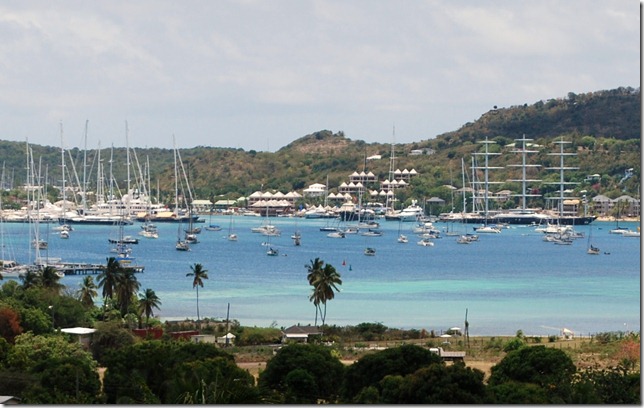 Looking over at Falmouth Harbour with the 3 masts of the Maltese Falcon on the far right
Looking over at Falmouth Harbour with the 3 masts of the Maltese Falcon on the far right
Friday we drove to the capital city, St. John’s, to check out the market. There was plenty of fresh produce and fish on offer, and I bought a young drinking coconut for my parents to try. That afternoon we had to move the boat (when the wind blew from certain angles, we ended up in the channel), but we managed to find a spot near Galleon Beach, quite close to my parents’ accommodation as of Saturday. They are in a beautiful villa overlooking the bay with an amazing view, particularly as the Antigua Classic Yacht Regatta is taking place and the classic boats are passing by.
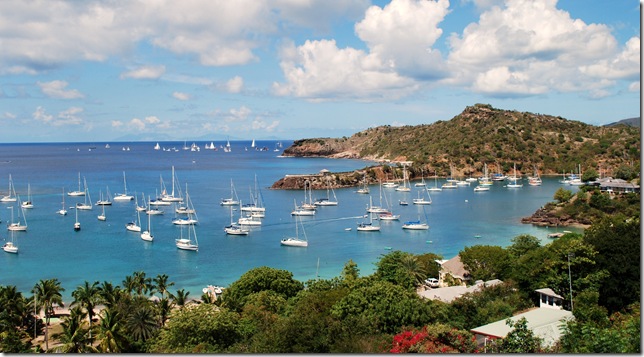 View of English Harbour from the villa (smaller boats beginning to race in the background)
View of English Harbour from the villa (smaller boats beginning to race in the background)
Saturday morning we took the boat out to get up close and personal with the classic yachts as they started the race. The older and larger gaff-rigged ones were our favorites. My mom typically gets seasick but was a trooper and is planning to do some sailing with us in the coming days.
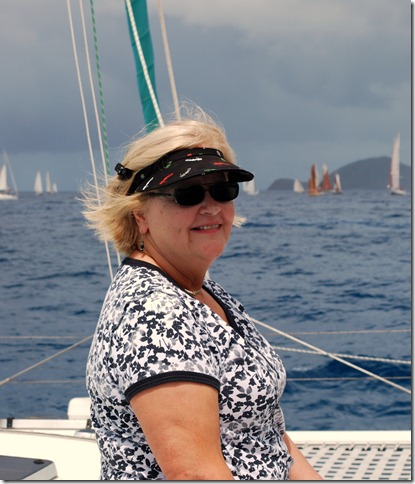 Proof that Rindy was out on the water and not feeding the fish
Proof that Rindy was out on the water and not feeding the fish
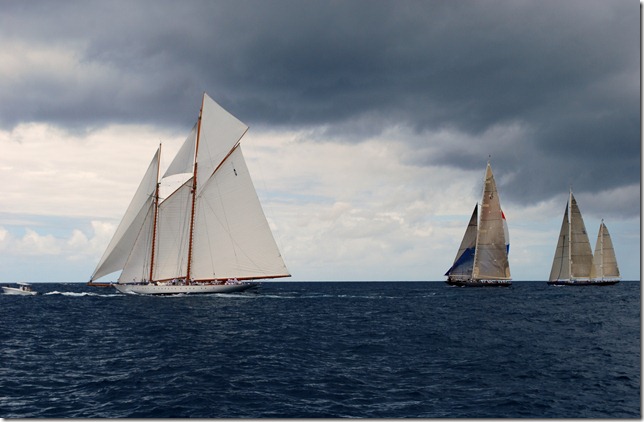 The big guns came out for the final round of the Classics Regatta
The big guns came out for the final round of the Classics Regatta
Other than that, we’ve been quite a bit of “liming”, which is the favorite past-time of Antiguans and means “cooling out”. My parents have definitely been inducted into the cruising lifestyle having learned to snorkel, eating fresh fish each night, and drinking sundowners. I think it’s safe to say that they are enjoying themselves!
Light winds and rain have been the order of the day lately. We left the Saints in a drizzle and made our way to Basse-Terre to check out on our way to Deshaies, our last anchorage in Guadeloupe. What should have been a simple stop to check-out during (French customs) business hours turned into an unexpected adventure. There’s supposed to be a customs office at Marina de Sens as well as in the main town, but after motoring into the marina and finding it packed and the fuel dock occupied, we decided to stop at the main town a mile and a half away, thinking there would be a better chance of finding someone in the office there anyway. The anchorage off of the town wasn’t the best, the commercial dock was empty, and the swell wasn’t too big, so we found a convenient spot to tie up to the dock and got permission to stay long enough to check out. My basic French eventually got me to the customs office where they told me sorry, go back to the marina. Can’t check out yachts here. I walked back to the marina, but didn’t see a customs office, so I asked around and was told to go to the Barracuda Restaurant. Not typical, but OK. I walked to the other side of the marina and found it was a very nice place with uniformed chefs and cooks getting ready for the lunch rush in a kitchen that was visible from the dining area. It turns out the main chef is also the customs guy. After checking several boiling pots on the stove, he took me into a closed Billabong-style surf wear shop next door, powered-up the computer used to as a cash register, and printed up my clearance after I’d filled in the form. Checking in and out can sometimes be a bit of an annoyance, but it’s never a bore.
We haven’t been fishing much, so I stopped on the way back to buy some fish at the market. Freshly caught mahi mahi, wahoo, tuna, and marlin were out on the chopping block and I got a pretty decent deal on some mahi mahi and wahoo. With Lauren’s parents coming to Antigua it will be nice to have fresh fish dinners at something other than the tourist price. Just to give an idea of the difference, I picked up enough mahi mahi and wahoo for about 9 servings, each larger than what you’d get in a restaurant for a little over $30 US. The restaurant at the dockyard here in Antigua is charging $45 US for one plate of wahoo.
When I got back to the boat I found out Lauren had been having an adventure as well. The swell had grown and docklines had chafed through while she was below. She was a little shaken up by the experience of colliding with the concrete wall (no real harm done, fortunately), but she had us tied back up securely and in a few minutes we were off for Deshaies.
We made Deshais before sunset. It’s one of those anchorages that almost everybody stops at on their way up or down the chain. We’re still getting used to the number of boats in the Caribbean and how tightly they get packed into anchorages. Deshaies had plenty of room for everyone, but it was still closely packed with 45 sailboats as well as a few local dive boats.
Thanks to light winds, our passage up to Antigua the next day was pretty uneventful. We even used the time to fill diesel tanks and Lauren gave the cockpit and deck a good cleaning. As we motored into Antigua’s English Harbour, we got a new lesson in what “crowded anchorage” means. This is Classic Regatta week and Antigua Sailing Race Week is coming up. The result is more boats and dinghies than we’ve ever seen in one place.
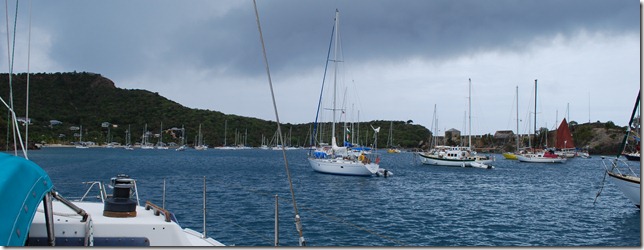 Looking from where we’re anchored across the channel toward Freeman Bay
Looking from where we’re anchored across the channel toward Freeman Bay
After checking in, we went ashore to do a little exploring and soon found ourselves in the middle of a party. We were walking down the street toward Falmouth Harbour when we saw Tracey walking toward us. She’d just arrived from Brazil by plane and we started catching up as we headed toward the yacht club. As full as English Harbour is, Falmouth Harbour made it look like a deserted backwater. The docks were jammed full of superyachts, mostly classic-style sailboats, including the ultra-modern square-rigged Maltese Falcon by Pereni Navi. There was a separate “harbour” just for dinghies from the armada of sailboats anchored and moored in the bay. The first part of the night’s festivities were sponsored by some European watch maker I’d never heard of, who must sell watches for the price of cars. They must be that expensive because their ads were just pictures of huge yachts and they took the opportunity to supply free drinks to everyone in the Harbour.
Mt. Gay sponsored the next portion of the evening with live music, cheap food, and cheap or free rum. The coveted red Mt. Gay hats were distributed to regatta participants and I was able to talk my way into a few of them after explaining that we’d sailed nearly 30,000 miles just to visit the Mt. Gay distillery in Barbados. The Caribbean is filled with a different type of sailor than the more remote anchorages of the Pacific and Indian Oceans. There are some old salts here, but there are also lots of charterers, people with a lot more money than sense or experience, boat bums who found an anchorage they won’t leave for 20 years or more (I’m not sure what some of them did with the money from selling their mast), European cruisers just starting to get nice and salty after crossing the Atlantic, Americans in shiney decked-out boats here for a run up and down the island chain, superyachts with uniformed crews that polish and clean then polish and clean some more, families, you name it. Everyone is represented here.
With so many different people around, we had to do a bit of mingling. Here’s a sampling of some of the people I enjoyed conversations with. It gives some feel for who’s here in addition to the owners and crew of the large, classic yachts: a Brit who lived aboard here for 20 years after retiring, a German owner/captain who charters his 60-foot sailboat for a route that covers the Med, the Caribbean, the Baltic, and St. Peterburg Russia, a local Rasta-style farmer with 3.5 acres that is mostly fruits and vegetables, but also includes a certain herb that he tries to sell at evening tourist gatherings, an American hiding from his ex-wife’s divorce lawyers for a few more years, a Swede who crossed the Atlantic with a partner and is now planning to head for the Panama Canal and attempt a circumnavigation, and a young man named Mario.
Mario was probably my favorite. He was born in Jamaica but has lots of family in the US and England, including a son in NYC. He’s working with a local company who is a distributor for Mt. Gay, so he was technically on the clock last night, but had plenty of time to chat. He left Jamaica because of all the violence in the cities and the lack of any job prospects after completing welding school. He’s had no problem fitting in and making friends here in Antigua and likes the more relaxed atmosphere. Since he was from Jamaica, we had to have a chat about music. While we’ve found that American hip-hop is popular the world-over, we were really surprised by how strong of an appeal Bob Marley still has to indigenous peoples and former slaves of all ages everywhere we’ve been. After reading Michener’s Caribbean over the last couple of weeks, it’s obvious that in addition to being a good musician, Marley captured quite eloquently the experiences and psyche shared by a lot of people after coming into contact with European society. Mario laughed and called Marley “old people” or “family” music. He’s right about that being the case here in the Caribbean. We like to listen to the local radio when we’re approaching a new country, and the music here even today is striking for its content. In the US, the girl you’re dancing with or the guy you’re in love with, or “bling” as Mario added, makes up for most of the lyrical content. The Caribbean has that too, but here there are also a lot of songs about life’s hardships, economic problems, politics and the government, etc. We even heard one really strange (for us) song on the bus in Dominca by a victim of childhood sexual abuse that passengers were singing along to. Mario just nodded his head vigorously and became a little animated when he said the difference is because in the US “you don’t have no hardships, no walkin’ to school with no shoes, no comin’ home and momma don’t have no food to give you to eat, no havin’ to go out in the street and rob someone just to have some food to eat.” In the US we think of much of the rest of the world as “poor” and behind, but really it’s just that we’re rich and lucky. Compared to much of the rest of the world, we’re more like the few guys with the crewed superyachts. Here in Antigua Mario’s had it much better. He’s got a good job, a girlfriend he’s thinking about proposing to, and enough money to soup up a Honda Civic and pay the tickets he gets for driving way too fast on the winding roads.


